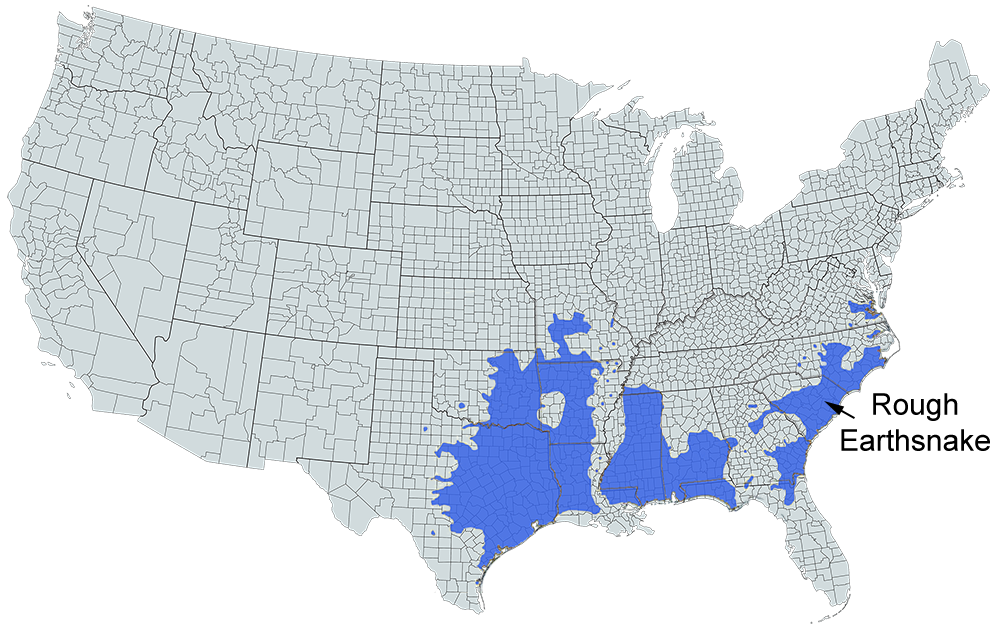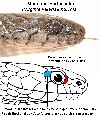Rough Earthsnake
Virginia striatula
** Harmless **
Common Name: |
Rough Earthsnake |
Scientific Name: |
Virginia striatula |
Etymology: |
|
Genus: |
Virginia |
Species: |
striatula is derived from the Latin word stria which means "furrow". |
Vernacular Names: |
Brown ground snake, ground snake, little brown snake, little striped snake, small brown viper, small-eyed brown snake, striated viper, worm snake. |
Average Length: |
7 - 10 in. (18 - 25.4 cm) |
Virginia Record Length: |
11.6 in. (26.9 cm) |
Record length: |
12.8 in. (32.4 cm) |
Systematics: Originally described as Coluber striatulus by Carolus Linnaeus in 1766, based on two specimens sent to him from "Carolina" by Alexander Garden. Schmidt (1953) restricted the type locality to Charleston, South Carolina. For over a century, this species resided in the genus Haldea, which was erected for it by Baird and Girard (1853). Numerous authors in the Virginia literature used Haldea striatula (e.g., Cope, 1900; Stejneger and Barbour, 1939; Schmidt, 1953; Burger, 1958; Conant, 1958). However, Dunn (1918,1936) and Stejneger and Barbour (1917, 1923, 1933) followed Fitzinger (1843) by using Potamophis striatulus. Parker (1938) pointed out that Potamophis had been designated for a snake on the Indian subcontinent 7 years prior to Fitzinger's work, thus making it unavailable for the Rough Earthsnake. Zillig (1958) pointed out that Garman (1883) was the first to note that Virginia striatula and V. valeriae were congeneric and that he believed that the genus Virginia, first used by Baird and Girard (1853) for V. valeriae, was the most appropriate genus for these two species. Since then Virginia authors have used V. striatula for this snake (e.g.. Hardy, 1972; Mitchell, 1974b; Conant, 1975; Martof et al., 1980; Linzey and Clifford, 1981; Blem and Blem, 1985). No subspecies are recognized. McVay and Carstens (2013, Mol. Phylogenet. Evol. 68: 425–431) found that Virginia is polyphyletic based on a multi-locus nuclear dataset, and resurrected Haldea for V. striatula.
Description: A small snake with a somewhat cone-shaped head reaching a maximum total length of 324 mm (12.8 inches) (Conant and Conant, 1991). In Virginia, maximum known snout-vent length (SVL) is 252 mm (9.9 inches) and maximum total length is 296 mm (11.6 inches). In the present study, tail length/total length was 14.2-21.0% (ave. = 17.3 ± 1.9, n = 52).
Scutellation: Ventrals 114-133 (ave. = 121.4 ± 4.2, n = 58); subcaudals 28-45 (ave. =37.7 ± 3.5, n = 52); ventrals + subcaudals 159.6 ± 2.5 (155-167, n = 52); dorsal scales keeled, scale rows 17 at midbody; anal plate usually divided; infralabials 6/6 (86.2%, n = 58) or other combinations of 5-7 (13.8%); supralabials 5/5 (92.2%, n = 56) or other combinations of 4-6 (7.6%); internasal scale 1; loreal present; preoculars absent; postoculars 1/1; temporal scales usually 1+2/1+2 (62.9%, n = 35) but may be other combinations of 1-2 (37.1%).
Coloration and Pattern: Dorsum of body uniformly dark brown to gray without pattern; venter cream; head dark brown to black, particularly toward snout; lower margin of supralabials, chin, and infralabials white; immatures and some adults may possess a faded, light-brown to yellowish crossband across posterior parietal scales.
Sexual Dimorphism: Adult females reached a larger average SVL (214.3 ± 18.4 mm, 178-252, n = 24) than adult males (181.4 ± 13.5 mm, 160- 205, n = 19) and reached a longer total length (296 mm, males 252 mm). Sexual dimorphism index was 0.18. Tail length/total length was higher in males (ave. = 19.5 ± 0.7%, 18.2-21.0, n = 17) than females (ave. = 16.2 ± 1.3%, 14.2-20.3, n = 35). Males had a lower average number of ventral scales (117.6 ± 2.1, 114-122, n = 23) but a higher average number of subcaudal scales (41.4 ± 1.5, 39-44, n = 17) than females (ventrals 123.9 ± 3.4, 114-133, n = 35; subcaudals 36.0 ± 2.8,28-45, n = 35). The average number of ventrals + subcaudals was not sexually dimorphic (males 159.1 ± 2.3, 156-163, n = 17; females 159.9 ± 2.6,155-167, n = 35). Males and females from eastern Henrico County were not significantly different in SVL, but were different in relative tail lengths and number of ventrals and subcaudals (Blem and Blem, 1985).
Juveniles: Juveniles are darker than adults at birth, and possess a cream to yellow crossband on the back of the black head. The crossband darkens with age but may not become completely obscured. Neonates were 67-86 mm SVL (ave. = 77.9 ± 6.4, n = 17) and 86-105 mm total length (ave. = 96.5 ± 6.8), and weighed 0.40-0.42 g (ave. = 0.41, based on means of 2 litters).
Confusing Species: The species most likely to be confused with this snake is Virginia valeriae, which has smooth scales and tiny black dorsal dots. It also lacks the somewhat darkened pointed snout. Other potentially confusing species are Storeria dekayi, with paired, black, dorsal spots; Storeria occipitomaculata, with a red venter and middorsal stripe; Tantilla coronata, with a tan dorsum and a black crossband on the neck; and Carphophis amoenus, which is pink on the venter and lower sides. Ring-Necked Snakes (Diadophis) have a distinct collar on the neck and often black spots on the venter.
Geographic Variation: The sample sizes among regions are too small to allow definitive conclusions about geographic variation in Virginia. Blem and Blem (1985) found that the number of ventrals and subcaudals for a Virginia sample averaged fewer than those found in a Texas sample by Clark (1964).
Biology: Rough Earthsnakes are entirely terrestrial and are most commonly found under objects on the ground surface. Most have been found under household trash and construction debris. However, this is primarily a species of open hardwoods, pine woods, grassy areas, and suburban woodlots-areas with sunlit openings. Movements occur at night and at dusk, especially in the warm months. Museum records indicate that H. striatula has been found 2 March-20 November; however, it is far less abundant after July than before that month, probably going underground in response to the drying surface conditions typical of late summer in Virginia.
The primary prey of H. striatula is earthworms. This was the only prey type found in stomachs examined by me, Blem and Blem (1985), and Brown (1979). Other prey recorded for this species were insects, sowbugs, slugs, snails, small frogs, and young lizards (Ernst and Barbour, 1989b). Gehlbach and Baldridge (1987) noted that the most common snake eaten by screech owls (Otus asio) in Texas was H. striatula. Linzey and Clifford (1981) speculated that Mole Kingsnakes (Lampropeltis calligaster), Eastern Milksnakes (L. triangulum), raccoons (Procyon lotor), and opossums (Didelphis virginiana) ate adults, and that large spiders and toads (Anaxyrus spp.) ate juveniles, but there is no confirmation for any of these species.
Haldea striatula is viviparous. Mating is known to occur in March and April in Texas (Clark, 1964). Copulation was observed on 30 March 1982 in Virginia (D. Greene in Blem and Blem, 1985). The smallest mature male in the Virginia sample was 160 mm SVL and the smallest mature female was 178 mm SVL. Known birth dates are between 6 July and 14 August. Litter size was 5-8 (ave. = 6.3 ± 0.9, n = 9). Blem and Blem (1985) reported a minimum adult female SVL of 175 mm, ovulation in mid- to late May, a birth date of 10 August, and litter sizes of 4-10 (ave. = 6.0 ± 1.5, n = 24) for a Henrico County population.
Rossi and Rossi (1993) reported two litters of eight neonates each born in August 1989 to females collected in northern Virginia. Three of the female neonates grew in captivity and later (28 March-6 April 1991) copulated with a male from Florida; one containing six full-term embryos died on 30 June, the second gave birth to five young on 1 July, and the third produced four young on 2 July of that year.
The only published study of the population ecology of this species is by Clark and Fleet (1976) for a Texas population. They found that (1) the average home range size was up to 100 m2, (2) the population sex ratio was 1:1, (3) there was an annual variation in the estimated number of snakes in the area studied (229-348 snakes per hectare), and (4) sexual maturity was reached in 1 year of growth for males and 2 years for females.
This snake will not bite upon capture but may emit musk from glands at the base of the tail or even feces. They are known to "play dead," becoming rigid with mouth open and tongue protruding (Thomas and Hendricks, 1976).
Remarks: Other common names in Virginia are striped ground snake (Dunn, 1936), and brown snake, worm snake, and ground snake (Linzey and Clifford, 1981).
Conservation and Management: Haldea striatula is not a species of special concern in Virginia because of its abundance in areas with scattered construction and household debris, and its wide distribution in southeastern Virginia. Death from pesticide poisoning was reported for a Mississippi specimen of H. striatula by Ferguson (1963). The extent of projected urbanization in the portion of Virginia from which most localities are known (the Richmond-to-Norfolk portion of the urban crescent) suggests that some populations will be lost over the next decade or two. Active management that will help to ensure the presence of this species includes the creation of natural landscaped areas with adjacent woodlots, the protection of forest fragments in urban and suburban areas, and the reduction of pesticide use.
References for Life History
Photos:
*Click on a thumbnail for a larger version.
Verified County/City Occurrence
Brunswick
Charles City
Chesterfield
Gloucester
Henrico
James City
Mathews
Powhatan
Southampton
Surry
York
CITIES
Chesapeake
Emporia
Franklin
Hampton
Newport News
Richmond
Suffolk
Verified in 11 counties and 7 cities.
U.S. Range

US range map based on work done by The Center for North American Herpetology (cnah.org) and Travis W. Taggart.








